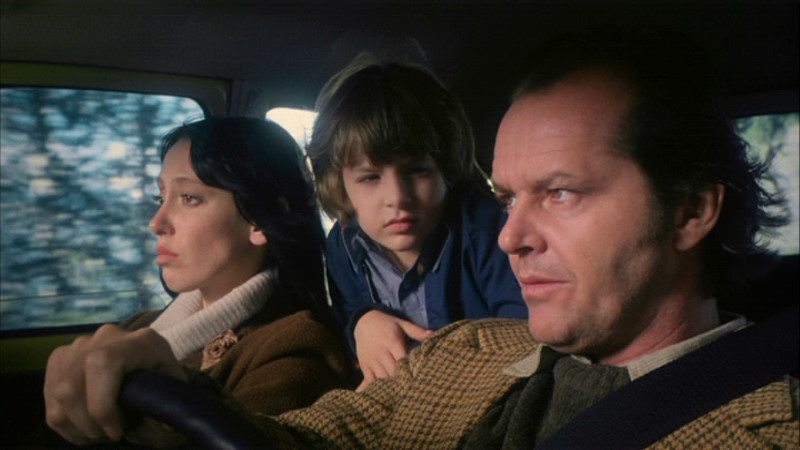
Before watching Room 237, I was both excited and apprehensive. I was excited because I have spent many hours reading about Kubrick, analysis of his films, and the multiple interpretations therein. I was, for similar reasons, hesitant. Recently, I had been working on an essay focusing on specific themes within The Shining. It is slated for publication later this year, and I was a bit nervous that Room 237 would offer the same or similar perspective and thus make it seem as if I had simply summarized the film and added an extra page or two.
However, while Room 237 briefly hints at the notion on which I extrapolate for twenty-five-or-so pages, its analysis is minimal and its assumptions precarious at best.
This is not to say that the film doesn’t offer some fine theories about Kubrick’s intent or the various themes that run through The Shining. In fact, it offers some pretty interesting ones; but, they often come across more like conspiracy theories hatched by career film bloggers. Now, I understand the irony of using that occupation as a pejorative, but Room 237 feels more disjointed than any possible viewing of the film it is inspired by.
The most compelling argument about The Shining is probably its most publicized: visual connections that Stanley Kubrick draws to the Holocaust. His use of the numbers 7 and 42 as well as some of the subliminal Nazi imagery is rather well-publicized in critical film studies, so there’s no lack of evidence.
But everything else feels like pure conjecture. Room 237 is relayed to us through five narrators, each with a different take on the film.
Four out of the five offer little to no substantive evidence to support their arguments. They offer interesting ideas but with nothing to support them. And the editors are seemingly left with little recourse as well. Much of the visual evidence in Room 237 is comprised of other films outside the scope of The Shining.
While a fair amount of scholarship has been written about The Shining and the Holocaust, evidence offered in the film consists of its narrator stating the connection and then cuts to WWII films, images of Joseph Goebbels, video of Adolf Hitler, and soldiers goose-stepping. Room 237, ironically, propagandizes its own views.
Another premise is that Kubrick, who is rumored to have filmed the – again – rumored fake Apollo 11 moon landing, is using The Shining to tell the world about his role in the grand ruse as well as to find closure within himself. Interesting premise, no? Certainly, but not in the way it’s presented. The only solid evidence offered is Danny’s wearing of a knit, Apollo 11 sweater. This is a fine starting point, but every argument around it revolves around questions that the narrator believes Kubrick would hypothetically be dealing with in this conspiracy. The main problem inherent to this thesis is that it is a conspiracy theory predicated on the veracity of two other conspiracy theories: 1) the moon landing was faked 2) Kubrick was involved in the fake.
The secondary problem is that he offers obscure evidence linking the room 237 in the film to the distance from the Earth to the moon, which he claims is 237,000 miles. The problem here is that the actual distance is listed as 238,900. Granted, this is pretty darn close, but “close enough” is not a good argument, particularly when the basis of the argument is fairly outlandish.
I’m not against outlandish, but the scholar’s job is to make me acknowledge the outlandish has a legitimate argument.
The same counterargument exists for the narrator who somehow finds the mythical Minotaur in a poster of someone skiing. Admittedly, the presence of the labyrinthine topiary offers up the sure possibility of a metaphorical Minotaur, and Jack Torrence growling and snarling like a rabid dog as he searches for his progeny toward the end of the film is a fine candidate. However, our narrator jumps over the obvious and creates a connection that I needed to watch three times before giving up on it.
The bigger issue with this theory is that I’m not sure why it matters. What purpose does this symbolism serve in the overall film? Why is Jack the Minotaur? Is Danny Theseus? Who is Daedalus? And what does any of this have to do with the cowboy riding a bull in the poster opposite the poster of the “Minotaur”? I ask this question because the narrator intentionally notes the poster as if it’s an automatic connection. Is it as simple as Cowboy vs. Bullboy? If so, my concern about its relevance still stands.
If nothing else, Room 237 warns us of the dangers of over-thinking films. I’m often the first one to read deeply into a Kubrick film and offer a wacky thesis, but I also let it die if it holds water like a one-ply sheet of toilet paper. Sometimes, continuity issues are just continuity issues. A chair present in one scene while absent after a cut doesn’t always lead to genius. Sometimes, it’s just a screw up. Sometimes it’s valid. The way to tell the difference is to gauge it against the events throughout the rest of the film. Sure, The Overlook is haunted, but there are plenty of subtle and not-so-subtle sequences to show this: blood from the elevator; blonde-cum-rotten-hag in a tub; a specter bartender, waiter, and gala; Jack’s inexplicable release from the storage cooler; Danny’s ability to “shine”; creepy ghost sisters; Kubrick playing masterfully with depth of field, making people disappear behind columns and reappear after an extended period of time.
An unassuming chair in the background that disappears between cuts is hardly ominous; it’s just poor note-taking.
In closing, watch The Shining and know that Kubrick offers a lot more than a quotidian tale of horror, ghosts, and goblins. Watch Room 237 if you want some fun topics for a paper that you don’t intend to research in the least.





